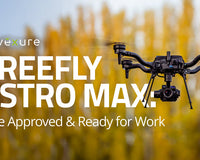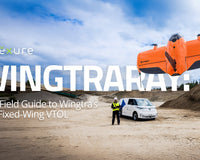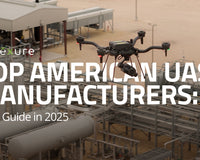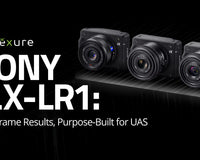Survey‑grade LiDAR has transformed the way professionals map, measure, and manage changes across topography, infrastructure, and vegetation. Yet as project demands grow more complex, operators continue to hit the same bottlenecks: limited penetration in dense canopy, inconsistent accuracy across different elevations, and data workflows that require hours of cleanup before models are client-ready.
For many teams, the next leap isn’t just about sharper point clouds; it’s about scalability and reliability in the field. DJI’s Zenmuse L3 has recently been released as the company’s most advanced aerial LiDAR payload to date, built to handle high‑volume mapping missions that once required multiple flights or mixed hardware setups.
In this guide, we’ll look at how the L3 compares to its predecessor, the Zenmuse L2, and what those differences mean in practical terms. Whether you’re capturing DEMs in vegetation‑dense corridors, surveying active construction zones, or managing open‑pit mines, understanding where the L3 is positioned in the market can help you make the right decision for your fleet.
Next, let’s look at what the Zenmuse L3 brings to the table.
Zenmuse L3 at a Glance

The Zenmuse L3 was designed for high-throughput, survey-grade missions where speed, accuracy, and flexibility are critical. Engineered exclusively for the DJI Matrice 400 platform, the L3 captures dense, highly accurate point clouds while simultaneously collecting dual-camera RGB imagery, streamlining photogrammetry and terrain modeling into a single, efficient flight.
Zenmuse L3 Key Features:
-
Extended Range
Captures returns from surfaces up to 950 meters away, even at low reflectivity and high ambient light levels. -
Multi-Return Support
Delivers up to 16 returns per pulse and supports pulse rates up to 2 million/sec for tunable density and deeper canopy penetration. -
Small Spot, High Energy Beam
A narrow 0.25 mrad divergence results in a laser spot five times smaller than L2’s, ideal for detecting thin structures like wires and branches. -
Dual 100MP RGB Mapping Cameras
Two synchronized 100MP 4/3 CMOS sensors with a combined 107° field of view capture photogrammetry-grade imagery and colorized point cloud data. -
High-Altitude Coverage & Efficiency
Supports flight altitudes between 300 and 500 meters, enabling up to 10 km² of mapping per flight and up to 100 km² per day.
Zenmuse L3 vs L2: Side-by-Side Comparison
The Zenmuse L3 introduces major upgrades in laser performance, RGB imaging, and data throughput, but its biggest limitation may be one of logistics: aircraft compatibility. Below, we break down the most important technical and operational differences between the L3 and the L2, so you can make an informed decision for your next mapping mission.
Detection Range & Return Capabilities

A LiDAR sensor’s effectiveness often depends on its range, its ability to handle reflectivity, and the number of surfaces it can distinguish per pulse. This is especially important in vegetated, irregular, or cluttered environments.
|
Feature |
Zenmuse L3 |
Zenmuse L2 |
|
Max Detection Range |
950 m @ 10% reflectivity, 100 klx |
450 m @ 50% reflectivity, 0 klx |
|
Min Detection Range |
3 m |
3 m |
|
Returns per Pulse |
Up to 16 |
Up to 5 |
|
Max Pulse Rate |
2,000,000 pulses/sec |
240,000 pulses/sec (1.2M total w/ returns) |
|
Laser Wavelength |
1535 nm |
905 nm |
|
Beam Divergence |
0.25 mrad |
0.2 H × 0.6 V mrad |
|
Laser Spot Size @ 100m |
~20 mm |
40 mm × 120 mm |
What this means:
The L3 offers significantly longer range, more returns per pulse, and a much smaller spot size, ideal for capturing finer terrain features and penetrating vegetation at high altitudes.
Accuracy & Point Cloud Quality

When accuracy is everything, especially for engineering-grade work, even small improvements in point density and angular precision leads to better deliverables and less time in post-processing.
|
Feature |
Zenmuse L3 |
Zenmuse L2 |
|
Vertical Accuracy @ 120 m |
3 cm (RMSE) |
4 cm (RMSE) |
|
Horizontal Accuracy @ 120 m |
4 cm (RMSE) |
5 cm (RMSE) |
|
Point Cloud Thickness |
1.2 cm @ 120 m |
Not specified |
|
IMU Post-Processed Accuracy |
Pitch/Roll: 0.01° / Yaw: 0.02° |
Pitch/Roll: 0.025° / Yaw: 0.05° |
|
Ranging Repeatability |
5 mm @ 150 m |
2 cm @ 150 m |
What this means:
L3’s point cloud is thinner, more consistent, and captured at higher altitudes—making it better suited for high-precision elevation models and dense terrain modeling.
RGB Mapping System

RGB capability isn’t just a bonus, it’s central to workflows that rely on colorized point clouds, orthomosaics, or photogrammetry. The L3’s dual-camera architecture represents a major step up.
|
Feature |
Zenmuse L3 |
Zenmuse L2 |
|
Sensor Configuration |
Dual 4/3 CMOS, 100 MP each |
Single 4/3 CMOS, 20 MP |
|
Field of View (Combined) |
107° Horizontal |
84° Horizontal |
|
Shutter |
Mechanical |
Mechanical |
|
Colorized Point Clouds |
Yes |
Yes |
|
Minimum Capture Interval |
0.5–1.2 sec (mode dependent) |
0.7 sec |
What this means:
With higher resolution, wider coverage, and more light sensitivity, the L3’s RGB system supports both colorization and photogrammetry at scale—especially valuable for inspections, vegetation classification, and 3D reconstruction.
Scanning Modes & Visualization
Scanning patterns and real-time visualization tools impact how well a payload adapts to corridors, elevation shifts, and operational visibility during flight.
|
Feature |
Zenmuse L3 |
Zenmuse L2 |
|
Scanning Modes |
Linear, Star-Shaped, Non-Repetitive |
Repetitive, Non-Repetitive |
|
Power Line Follow |
Yes (enhanced, up to 130 m altitude) |
Yes (standard) |
|
Real-Time Point Cloud Preview |
Yes (2D/3D via SLAM) |
Yes |
|
Split-Screen Visualization |
Yes (RGB + Point Cloud) |
No |
What this means:
L3 introduces more flexible scan modes for tailored data capture, and its real-time tools allow better mission verification before landing.
Coverage & Efficiency
Flight efficiency isn’t just about battery life. The ability to fly higher, cover more ground, and maintain accuracy determines how scalable your workflow really is.
|
Feature |
Zenmuse L3 |
Zenmuse L2 |
|
Single Flight Coverage |
Up to 10 km² |
Up to 2.5 km² |
|
Max Daily Coverage |
Up to 100 km²/day |
Estimated 10 km²/day |
|
Optimal Flight Altitude |
300–500 m |
≤ 120 m |
|
Efficiency Focus |
Long-range, high-output survey workflows |
Moderate-scale, lower altitude missions |
What this means:
L3’s extended range and altitude envelope allow teams to tackle large-area surveys with fewer flights and reduced field time.
Aircraft Compatibility
This is going to be the constraint for most buyers: the Zenmuse L3 is only compatible with the Matrice 400. L2 remains the go-to option for M300 and M350 users.
|
Feature |
Zenmuse L3 |
Zenmuse L2 |
|
Supported Aircraft |
Matrice 400 only |
Matrice 300 RTK / 350 RTK / 400 |
|
Required Mount |
L3 Single Gimbal Connector (E1 port only) |
Standard Downward Gimbal Mount |
|
Remote Controller |
RC Plus 2 only |
RC Plus / RC Plus 2 |
Important: Zenmuse L3 cannot be mounted on the Matrice 300 or 350. If you’re not already flying a Matrice 400, this upgrade requires a platform transition.
Pricing & Availability
While L3 comes at a higher price point, its ability to map at scale with more efficient flight paths can reduce mission costs over time.
|
Feature |
Zenmuse L3 |
Zenmuse L2 |
|
MSRP |
$17,400 USD |
$13,230 USD |
|
Availability (US) |
Late November to Early December 2025 |
Available Now |
What this means:
If you’re planning to scale up operations or already transitioning to the M400, L3’s capabilities may justify the investment, especially for large-area, multi-discipline survey teams.
Which DJI LiDAR Payload Is Right for You?
The Zenmuse L3 delivers clear advantages for teams ready to scale their mapping workflows like higher range, more returns, better photogrammetry integration, and broader daily coverage. If you’re already flying the Matrice 400 or considering an upgrade to DJI’s latest enterprise platform, the L3 offers a measurable performance boost across almost every spec.
That said, the L3 is only compatible with the Matrice 400. If you’re currently operating a Matrice 300 or 350 RTK and not planning to transition platforms, the Zenmuse L2 remains a highly capable, field-proven option. It still offers strong accuracy, reliable penetration, and excellent efficiency for corridor mapping, forestry, and general topographic survey work.
Ultimately, the decision comes down to your aircraft and the scale of the missions you need to fly. If large-area throughput, deeper canopy penetration, or higher-resolution RGB capture are starting to become limiting factors, the L3 makes a compelling case to build your next LiDAR program around the M400.










